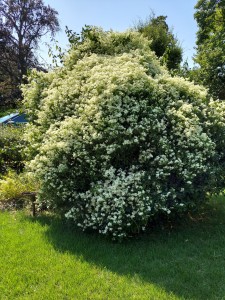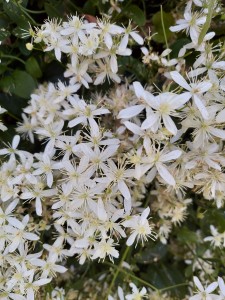My behemoth quince bush has been taken over by a plant that has had more names than a check forger, is bound and determined to run completely out of control, and makes regular, unscheduled appearances in respectable gardens everywhere. Sweet autumn clematis is the plant, and if America’s Most Wanted had a plant list, this fall bloomer would surely be on it.
Sweet autumn clematis is known more properly right now as Clematis terniflora, or sometimes C. ternifolia. In the recent past it has also been known as C. paniculata, C. dioscoreifolia and C. maximowicziana. If you attempt to pronounce the latter, which is derived from the name of Karl Ivanovich Maximovicz, a nineteenth century Russian botanist, you can understand why even plant taxonomists may have felt the need for a name change. The current name, “terniflora,” is the one used by the Royal Horticultural Society and means “three-flowered”, which doesn’t make much sense, as the flowers have four petals apiece and do not cluster in groups of three. The less preferable and possibly mistaken “ternifolia” seems to make more sense, as it means “three-leaved,” and refers to the number of leaves usually found in the individual leaf clusters on the plant’s twining stems. “Paniculata” indicates that the flowers appear in panicles or dense clusters, with each one on its own separate stem.
No matter what you call it, the plant is a treat. The leaves are medium green and shaped like elongated hearts. In mild climates the foliage may be evergreen. Clematis terniflora comes into its glory in the early fall, when it covers itself with hundreds, if not thousands, of star-shaped flowers. While each one is only about an inch wide, a mature plant in full bloom becomes a sweet-smelling white canopy that canopy that can climb up to thirty feet or form a large clump on the ground. I have seen a picture of sweet autumn clematis growing in an enormous concrete urn, mounding over the top and cascading down the sides. If for some reason you don’t need a thirty-foot tall vine, you can rein it in at least a bit by hard spring pruning. It is also great for doing kudzu duty–covering everything from rusting equipment to old outhouses.
Unlike other vines that need to be tied to supports, sweet autumn clematis has twining stems that fasten themselves readily onto trellises, trees or anything else in their path. Its opportunistic climbing habit is more than matched by its opportunistic reproductive habits, and it seems to pop up everywhere. Dozens of plants have sprouted unbidden in my yard, and I’m sure that if I mowed the grass less often, there would be even more. As far as I know, nobody in the neighborhood has one, so the original seeds either blew in on a mighty wind or were “planted’ by passing birds.
At different times in the past I have had sweet autumn clematis scrambling through my flower beds, privet hedge, and holly trees. I generally put a stop to that behavior by pulling out the offender, unless it looks better than whatever area or specimen it is covering.
The plant is native to Japan, which accounts for one of its common names, “Japanese virgin’s bower”. According to horticultural historian Denise Wyles Adams, the species was introduced in the United States in 1864. It has succeeded well here–too well in some areas. According to some sources, it can be invasive in the south. Having seen it growing on railroad right of ways and other untenanted spaces in the Middle Atlantic States, I can understand how it might be a beautiful pest elsewhere as well.
Sweet autumn clematis also found its way to New Zealand, and, as Clematis paniculata, become so popular in that island country that it is also known as “New Zealand clematis.” Its elevated status was commemorated in 1967, when that government issued a new one dollar note with the signature white blooms on the reverse.
After the clematis blooms have faded, they are replaced by feathery silver seed heads that last into the late fall, and add ethereal beauty to the landscape. I leave mine on the vines–mostly because there are too many to clip off–and then prune the whole thing back in the spring. Of course, this laissez-faire approach results in more sweet autumn clematis, so I must maintain constant vigilance for the fast-growing seedlings.
Ideally sweet autumn clematis should have decent, well-drained soil, and at least some sunshine. However, if your garden environment is less than optimal, try it anyway. It will probably grow nicely on a diet of partial sunshine and total neglect.
If you wait long enough, a sweet autumn clematis will undoubtedly sprout in your yard. However, if you are impatient, contact Digging Dog Nursery, 31101 Middle Ridge Road, Albion, CA 95410, (707) 937-1130; www.diggingdog.com. Print catalog available. 

